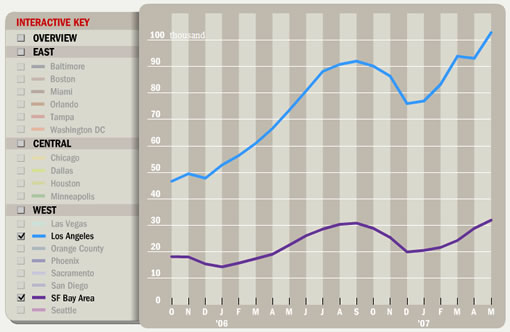
As a tipster notices, the Wall Street Journal along with a number of other websites jumped on ZipRealty’s recent inventory report.
The number of homes listed for sale in 18 major U.S. metropolitan areas at the end of May was up 5.1% from April, according to figures compiled by ZipRealty Inc., a national real-estate brokerage firm based in Emeryville, Calif.
The sizable increase is notable because, on a national basis, inventories of listed homes have typically been little changed in May during the past two decades, according to Credit Suisse Group. May is one of the peak home-selling months because families with children often aim to move during the summer vacation.
Some of the biggest inventory increases last month came in the metro areas of Seattle, up 12% from April; San Francisco, 11%; Los Angeles, 10%; and Washington, D.C., 9%.
Keep in mind, however, that the 11% increase for San Francisco is for the San Francisco Bay Area (those damn MSAs). Active inventory of listed single-family homes and condos in San Francisco proper was actually flat (if not slightly down) at the end of May (as compared to April). Regardless, it sill makes for a nice little interactive graph.
∙ San Francisco Housing Inventory Update: 6/01/07 [SocketSite]
∙ Housing Inventories Soar Across U.S. (Interactive Graph) [Wall Street Journal]
I will say, I have always been amazed at not only the consitently low level of inventory in SF (which is certainly nice for prices) but also the low number of transactions.
I believe this is why most of the SF statistics are actually for the bay area. The sample size of SF proper is just to small and could easily swing pretty dramatically.
It’s because there really aren’t that many properties in SF that are owner-occupied. More than 60% of San Franciscans rent. The city is only 750,000 people. There are nearly as many owner-occupied properties in metro Boise.
That’s because Boisians (?) can afford the median price in Boise. San Franciscians can’t afford the median price in SF.
It would be interesting to see what the distribution of ownership is (i.e. how many people own what percentage of SF real estate)
I always wonder, with the price of real estate constantly rising, eventually a termination point is reached where only a very few people can afford the housing here, and presumably many of these people will own more then one house, and in some cases a few will own many houses. Eventually we land in something resembling feudalism (if we aren’t there already…), with a large number of serfs paying tribute (i.e. “rent”) to a select few land barons.
So anybody know? Are the +/-775,000 housing units in SF controlled by a select 500k? 200k?
What’s the ratio of owners to units?
Brutus is right in that rents in this city are really not that expensive when comparing similar areas (Lincoln Park in Chicago or Santa Monica in L.A.), and the majority of this city rents. In my office there are 16 of us and only three of us own, the rest rent, where as in our Chicago office, over 80% own.
rg, while the percentage of the population that rents has something to do with affordability, it also has to do with the age of the housing stock, and the fact that SF has traditionally been majority rental. It is hard to destroy rentals and replace them with for-sale units. It just is. Call it politics, whatever. Any other city that has our age of housing stock and has not expanded it’s city limits in as long as we have is in the same boat. Even if all places in SF were to drop to affordable tomorrow, this place would still be majority renter.
ah boom,
There are nowhere near 775,000 units in SF. Each person doesn’t need a separate place to live. I don’t know the exact number (can’t find a good link right now), but it’s probably somewhere between 250,000 and 350,000. Here is a link (a little bit old – from 2000) that shows percentage of owners by neighborhood:
http://www.bae1.com/publications/SFHDNeighborhoods.pdf
Average household size in SF in 2000 is 2.3, if that helps.
Source:
http://www.mtc.ca.gov/maps_and_data/datamart/stats/house.htm
Well according to the 1990 numbers in Brutus’ PDF, there are 210K rental units and 115K owner occupied units in SF
It seems the real topic of the article which kicked off this thread turned out to be based on misleading data as reported by Zip Realty. The data Zip puts out is worth…..Zip. Enough said.
M.R.